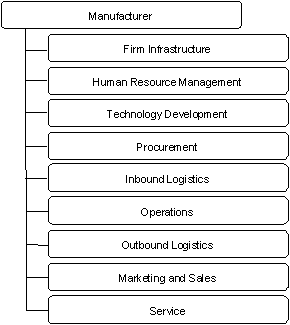

Even when the project scope is predetermined, it is sometimes difficult to take the first step in decomposition. In such cases, value chain analysis can be used to help clarify the situation.
In his discussion of the value chain (Competitive Advantage, New York Free Press, 1985), Michael Porter proposes a taxonomy into which all business activities can be classified. This taxonomy, when converted into a functional decomposition, can form a starting point for virtually any project.
Porter proposes five primary functions:
Several support functions will exist to provide a foundation for the primary ones. They must be identified by the analyst, but probably include these proposed by Porter:
Together, these functions can be used as a first-cut decomposition, as depicted in the following illustration.

You should feel free to use different names than those appearing in the illustration. Each business has its own nomenclature and every attempt should be made to conform to it.
When the customized, value-chain-oriented decomposition is complete, you can then identify where the project scope fits. Once that is understood, you can use the techniques described in Outlining Activities to continue the decomposition.
For example, assume that the analyst has been given the task of specifying an application that will track employee training. Based on the illustration, employee training is probably best considered a sub-function of Human Resource Management.
Alternatively, assume that a business re-engineering project has pointed out the need for an entirely new purchasing process. Purchasing is a sub-function of Procurement.
|
Copyright © 2014 CA.
All rights reserved.
|
|